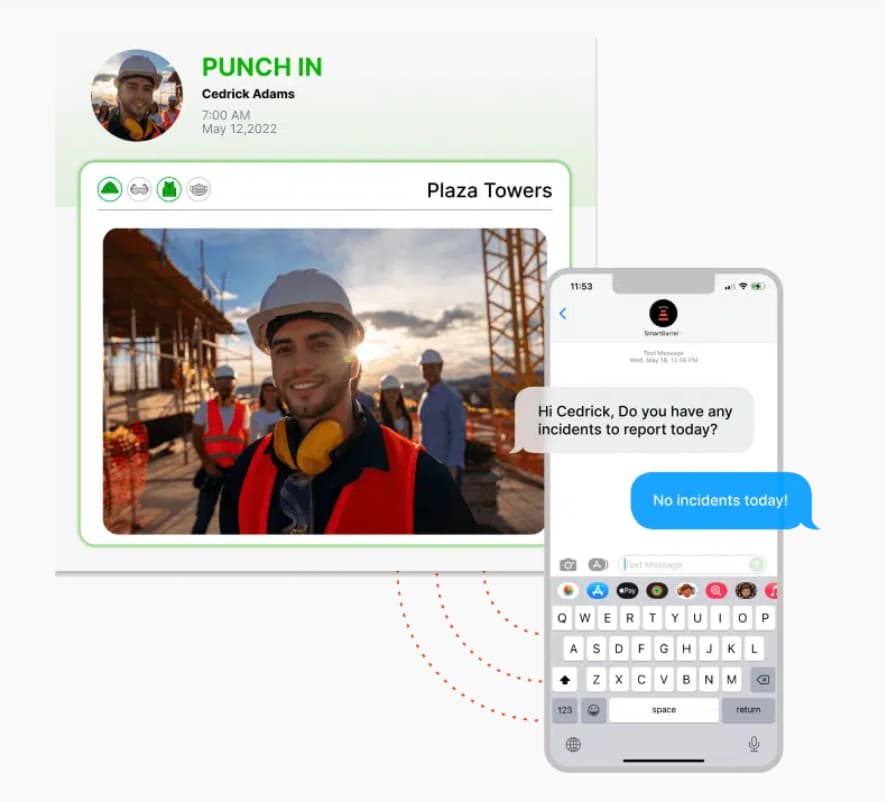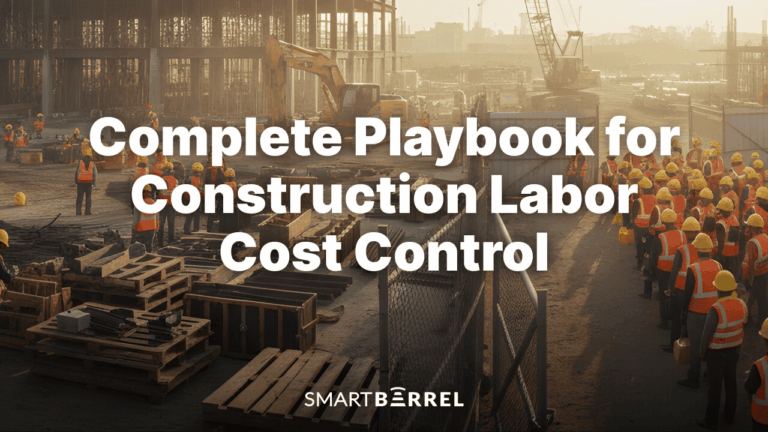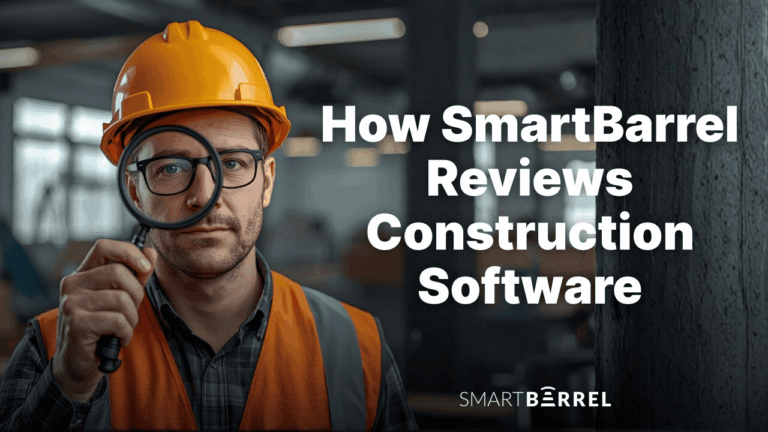Construction doesn’t fail because of the big stuff. It fails quietly, through missed labor hours, mispriced trailers, and forgotten line items you thought someone else was covering. These are your general conditions in construction, and they’re more than just indirect costs. They often decide whether your bid turns into a strong job or one that quietly reduces your profit.
Most subcontractors are forced to treat construction general conditions as an afterthought, not because they don’t care, but because the tools and processes they’ve had just haven’t made it easy. Some add a percentage. Others lean on experience. But without real support, even the best teams are left making educated guesses. Whether you’re in mechanical, electrical, drywall, or solar, if you’re not tracking general conditions, you’re leaving gaps that cost you later.
What are General Conditions in Construction?
General conditions in construction refer to the indirect costs that keep your jobsite running. These aren’t the materials or tools used to build a wall. These are the costs that support the people who build that wall.
They include field supervision, temporary power, dumpsters, jobsite trailers, safety gear, porta-johns, fences, and internet. It’s the behind-the-scenes stuff that doesn’t go on the wall but is essential to putting it there.
When subcontractors underprice these items or leave them out entirely, it is not a simple mistake. It puts the whole job at risk.
What’s Included in The General Conditions? Examples That Cost You
Here’s a look at a few common general conditions examples that should be in every estimator’s scope.
- Project Management: This includes the salaries of superintendents, assistant PMs, and office support staff on the job.
- Temporary Facilities: Job trailers, internet, water hookups, and power sources aren’t luxuries. They’re expected by owners and inspectors.
- Safety Equipment: This includes fall protection, PPE, fire extinguishers, and first aid stations. Failure to provide these will result in inspection failure.
- Cleaning and Sanitation: These include dumpsters, site brooms, daily cleanup crews, and porta-johns. This adds up quickly and is easy to overlook.
- Insurance and Bonds: General liability, builder’s risk, and performance bonds are all required in your construction contract.
Each of these items has a direct impact on your jobsite cost tracking and your ability to deliver.
Get Control of Your Time Tracking
How General Conditions are Estimated (Correctly)

This is where things go wrong fast. A flat 10% markup for the typical general conditions construction percentage might seem safe, but it often misses the detail that protects your margin. That’s why some subcontractors lose money even when their numbers win the bid.
Here’s a better approach, used by contractors who actually make money:
- Estimate the duration of the job—weeks or months. This dictates how long your general conditions will run.
- Break down the scope by job site needs. List out everything: toilets, trailers, temp power, supervision, cleanup, parking, even signage.
- Assign a time-based cost to each item. If a superintendent costs $2,500/week and you need him for 20 weeks, that’s $50,000. Not $25K. Here’s how to calculate direct labor cost accurately in construction.
- Factor in escalation if the project runs longer than 6–9 months.
- Review your past data. If you’re not tracking actuals from previous projects, you’re just guessing.
You don’t need a Ph.D. in estimating. You need a system, a spreadsheet, or a platform that tracks hours and costs and automates real-time field data.
How General Conditions Influence Bid Strategy
When you’re pricing a project, contractor general conditions can tip your bid from competitive to risky. Go too low and you may win the work, but lose your margin when site costs hit. Estimate too high, and you might lose the job before it starts. General conditions typically account for 5–10% of a construction project’s total budget, depending on project size and complexity.
So, what’s the move?
Start with the scope and schedule. Use historical project data. Build your general conditions in construction contract estimates line by line. Then and only then apply a margin or markup.
And remember: your competitors are underbidding on construction general conditions. If you estimate yours properly and win anyway, you’re probably more efficient. That’s a market advantage.
Are Construction General Conditions Hard Costs or Soft Costs?
It’s a common question—and a good one.
No, construction general conditions are not hard costs, but they’re not quite soft costs either. They live in a gray area. They’re job-specific but non-installation costs that support field operations.
Think of them as “enabling costs.” Without them, you can’t build. But they don’t show up in the finished product. That’s why so many owners question these line items. Your job is to show the math and track it daily so you can prove it when asked.
What Happens When You Miss Them?
Ignoring or underestimating construction general conditions throws the job off balance. Schedules slip. Crews get stretched. And you’re left chasing change orders without solid backup.
You risk:
- Blown profit margins
- Tighter cash flow
- Jobsite inefficiencies
- Invoicing delays
- Reputation damage
You can’t bill for extended construction general conditions if you didn’t track them from day one. Keep the records, protect your costs. If a project runs over, you’ll need to prove what you spent on-site supervision, trailers, power, and sanitation, to the hour.
If you can’t show it, you bear the loss.
Understanding Extended General Conditions
Every contractor has experienced a delayed project. Weather, owner indecision, and design changes lead to longer durations and higher costs. That’s where extended general conditions come into play.
These are the ongoing, time-based expenses that continue after the original schedule ends. You’re still covering the superintendent’s time, trailer rentals, temporary power, lighting, and daily site cleanup. Those costs don’t stop just because the schedule does.
But here’s the catch: you only get paid for them if you document them.
This is why it’s critical to use solutions with daily logs, geo-fenced time tracking, and digital records, so you can provide bulletproof evidence when it’s time to submit a change order or claim.
Why Owners Push Back on General Conditions (And How to Defend Them)
If you’ve ever had a GC or project owner push back on your general conditions line item, you’re not alone. It’s one of the most contested parts of any bid. Why? Because it’s not tied to a specific wall, floor, or system. They can appear as general overhead or unnecessary extras to the owner.
That’s a huge misconception.
Owners often see line items like “jobsite supervision” or “trailer lease” and assume they’re just part of your company’s overhead. But in reality, these are project-specific, time-sensitive costs that are essential to completing the work as outlined in the contract.
To defend them:
- Show the contract clause requiring on-site supervision
- Present daily logs proving staffing levels
- Break out actual costs (not lump sums)
- Use SmartBarrel’s historical job data as justification
When general conditions lack transparency, owners are more likely to question them. But when you support them with clear, traceable data, those concerns quickly fade. SOW and T&M contracts can also help define these expectations upfront.”
Get Control of Your Time Tracking
General Conditions in GMP and Lump Sum Contracts
General conditions in construction can be tricky if you’re working under a GMP (Guaranteed Maximum Price) or Lump Sum contract.
In GMP:
- They are often capped or pre-negotiated
- You may only recover extended costs through change orders
- You must track actuals with extreme precision
In Lump Sum:
- The risk falls on you
- General conditions are part of your lumped price
- There’s little room for midstream adjustments
In both cases, the difference is tracking. And knowing the right contract structure – lump sum vs time and materials – helps you estimate risk more effectively.
Time Tracking: The Hidden Link to General Conditions
Let’s get blunt: labor hours make or break general conditions in construction.
Most of your general conditions costs are labor-related—field supervision, admin, and temp labor for cleaning, safety, and logistics. Yet many subcontractors still track this with paper and guesswork. That leaves too much on the table. Smart time tracking is a direct link to accurate job costing in construction.

SmartBarrel solves this with AI-powered facial verification. This ensures only authorized workers can clock in. Add geo-fencing, and now you know your crew is on the right site. No disputes. No guesswork. Just accurate, real-time data.
Daily reports and payroll-ready exports help you back up and control your labor-driven general conditions costs with verified labor data.
Mistakes to Avoid When Estimating or Managing General Conditions
Managing general conditions in construction can make or break your bid. Small estimating errors or missed details often lead to big financial losses. Here’s how to avoid the most common mistakes that cost contractors time and money.
Mistake 1: Relying on Flat Percentages
Throwing a blanket 10% on general conditions isn’t accurate. Every job has different needs, durations, and site complexities. Build from actual cost breakdowns, not assumptions.
Mistake 2: Failing to Document
Without records, you can’t recover extended general conditions. Owners won’t pay for undocumented supervision, trailer rentals, or site utilities. Track every cost from day one.
Mistake 3: Confusing General Requirements with General Conditions
They’re not the same. One defines what you must do; the other covers what it costs. Know the difference, or you’ll underbid or miss billable items.
General Requirements = contract specifications
General Conditions = actual jobsite costs to meet those specs
Mistake 4: Ignoring Field Data
If you’re not tracking hours, site conditions, or labor presence daily, you’re guessing. And in construction, guessing leads to losses. Real-time data protects your budget. Tools like SmartBarrel make it easy to track labor presence, hours, and jobsite activity without extra admin work.
Mistake 5: Delaying Cost Reviews
Waiting until project closeout to check costs is too late. By then, overages are unrecoverable. Review jobsite spending regularly to stay in control. With SmartBarrel’s daily logs and cost-coded reports, you don’t have to wait until the end to know where your labor dollars are going.
General conditions in construction are where the margin is made or lost. You can win the bid, but if your jobsite costs are off, the numbers will catch up fast.
Know the difference between general conditions and general requirements in construction. Track your hours. Use real jobsite tools. When in doubt, estimate high and back it up with data.
This isn’t just a theory. It’s reality.
SmartBarrel helps subcontractors eliminate payroll errors, stop time theft, and control labor-driven general conditions with zero guesswork. You work too hard to lose money to bad estimates. Control the field. Control the numbers. Control your profit.
So what are you waiting for? Book a demo with SmartBarrel now and experience the difference firsthand.





